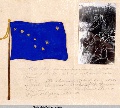Alaska was nearing its 60th year under the U.S. flag when Alaska Gov. George A. Parks, engaged in the press toward statehood, decided it was time the territory had its own official flag. The year was 1926, and Gov. Parks turned to the Alaska Chapter of the American Legion to lend assistance. Legion organizers launched a novel idea: a flag design contest among Alaska's schoolchildren in grades 7 through 12.
More than 700 entries from all over the territory were considered before 142 were sent to Juneau for the final decision. Among the finalists were children whose names would one day become prominent in Alaska, such as historian Robert N. DeArmond, photographer Steve McCutcheon, and politician and journalist Paul Solka, Jr. (Many of those original flag designs are part of the American Legion Collection now held by the Alaska State Museum in Juneau. They can be viewed online through the Alaska Digital Archives.)
Ultimately the selection committee chose a flag by John Ben "Benny" Benson, Jr., a 13-year-old boy who attended the Territorial School at Seward. Benson was born at Chignik to John Benson, Sr., a Swedish man, and Tatiana Schebolein, who was of Aleut and Russian heritage. When Benny was three years old, his mother died and his father's poor health, among other circumstances, forced his father to break up the family. Benny and his younger brother Carl were sent to the Jesse Lee Memorial Home for Orphans in Unalaska; a sister was sent to Oregon. Benny and Carl Benson lived at Unalaska until 1925, when the institution and its residents were relocated to Seward, a more central location.
Benny Benson submitted several designs for the contest, including one with Mount McKinley as the central feature; another included a dog team and the year 1867, when the U.S. purchased Alaska from Russia. For his winning design, however, Benson used blue paint and construction paper, placing the Big Dipper and North Star (the Ursa Major constellation) against a blue background. Handwritten notes on the art explain his reasoning: "The blue field is for the Alaska sky and the foret-me-not [sic], an Alaskan flower. The North Star is for the future state of Alaska, the most northerly in the union. The Dipper is for the Great Bear, symbolising strenth [sic]."
On May 2, 1927, the Territorial Legislature unanimously passed an act to adopt Benson's design as the official flag. His prize was an engraved watch and $1,000 to pay for a trip to Washington, D.C., with the intent that Benson would present the flag to President Calvin Coolidge in person. When those travel plans did not work out, the Legislature set aside the money for Benson's further education.
Alaska's new flag of blue and gold silk first flew over the Jesse Lee Home on July 9, which is now recognized annually as Alaska Flag Day. During the special ceremony, Benson received his gold watch, which had been engraved with the flag design. Later, the $1,000 award helped pay for schooling in diesel mechanics in Seattle. As an adult, Benson made his home in Kodiak, where he raised two daughters and became a grandfather. Occasionally he made and signed replicas of the flag that he designed. The last one he made, at age 58, is now on display at the Alaskan Native Heritage Center in Anchorage.
Benson worked as a master carpenter and as an airplane mechanic for Kodiak Airways from 1950 until his death on July 2, 1972. Having achieved celebrity at such a young age, Benson nonetheless is remembered on Kodiak as an unassuming man.
Anchorage's Benson Boulevard is named for him, as well as a secondary vocational education school. In Kodiak, Benny Benson Drive honors their longtime resident. In 1991, the Alaska Plant Materials Center, Alaska Department of Natural Resources, released a variety of Kodiak wild grass named Benson beach wild rye.
Seward warmly remembers the young boy whose love for Alaska is reflected in the beauty of the flag. The city erected a monument in Benny Benson's honor at Mile 1.4 of the Seward Highway. The roadside park is near the entrance to the town, across from the small boat harbor. In 1964, following the massive destruction of the Good Friday Earthquake, the Jesse Lee Home moved again, from Seward to Anchorage. In 1970, it merged with Lutheran Youth Services and the Anchorage Christian Children's Home to create Alaska Children's Services. Since 1991, ACS has hosted the Alaska Flag Day activities for families, and retells the story of how one young boy forever left his mark on Alaska.
|
 |
 |
| Benny Benson holding the Alaska state flag |
|
|
|
 |
| Alaska State Flag |
|
|
|
 |
| Benny Benson and Bob Bartlett |
|
|
|
 |
| Gov. Egan with Benny Benson |
|
|
|
|




